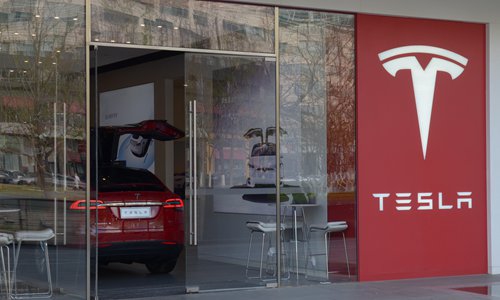Extended subsidies on NEVs set to boost industrial chain, spur output by 23%: analysts
By Zhang Hongpei Source:Global Times Published: 2020/4/25 0:28:01

A Tesla store in Beijing Photo: IC
China's new subsidy policy for the new-energy vehicle (NEV) sector - a 10-percent cut this year instead of the previous plan of phasing out incentives by year end - will help automakers weather the storm caused by the COVID-19 pandemic, enabling them to win more time to advance their technologies and become more competitive on their own, industry analysts said on Friday.
The comment followed China's Finance Ministry's announcement on Thursday that subsidies will be lowered 10 percent this year and, in principle, will be reduced by a further 20 percent in 2021 and 30 percent in 2022.
"Compared with the subsidy reduction last year, the 10 percent cut is quite mild, indicating the nation's determination in supporting the growth of the NEV sector," an industry insider who asked to remain anonymous told the Global Times on Friday.
NEV sales in China tumbled in the second half of 2019 due to a large subsidy cut. Sales stood at 1.21 million units, a 4-percent-year-on-year decline and the first such fall in over a decade.
The subsidy details came after an announcement earlier this month by the State Council, China's Cabinet, that China decided to extend the subsidies for NEVs to 2022 rather than the previous schedule of phasing them out by the end of this year. China has been subsidizing the NEV sector since 2009.
Buoyed by the supportive policy, there is hope that NEV production this year can reach a previous estimate of 1.6 million units, up 23 percent year on year, according to Cui Dongshu, secretary general of the China Passenger Car Association.
"It is an optimistic estimate, while some industry watchers forecast the number this year will be as flat as 2019," Cui told the Global Times.
The new subsidy policy, however, sets a price threshold for the first time. It applies only to passenger cars of pre-subsidy prices of no more than 300,000 yuan ($42,376), which is likely to exclude premium electric vehicles such as Tesla and BMW.
There has been heated discussion whether the new policy is directed at US electric vehicle (EV)giant Tesla since the latter's made-in-China Model 3 vehicles - both the standard range plus version and the long range version - are above the threshold of 300,000 yuan before incentives.
He Xiaopeng, founder and chairman of Chinese EV start-up Xpeng Motors, said on Sina Weibo on Friday that "I assume the long-range version of the Chinese-made Tesla Model 3 will reduce its price by 61,500 yuan after subsidies within the year. If so, it will cause mounting competitive pressure in the segment of EVs priced between 150,000 yuan to 400,000 yuan. All of us should be prepared."
"It is probable that the price threshold was designed to limit Tesla, however, it offers reasons for Tesla to lower its prices, a move that would definitely batter domestic EV brands," Li Xiang, CEO of Lixiang Automotive, posted on Sina Weibo on Thursday.
It is worth noticing that Tesla increased its Model 3 vehicle prices Friday morning, contrary to what the market had expected. The standard range plus version went up by 4,500 yuan while the long range version went up by 5,000 yuan.
It is highly likely that Tesla will bring down the Model 3 prices to within 300,000 yuan before the new policy's transition period ends on July 22, industry watchers said after the price increase.
According to Cui, it is reasonable to set the watershed of 300,000 yuan for the subsidy as it helps enhance competitiveness of NEVs in terms of price in a bid to compete with internal combustion vehicles at the same price level.
"It is also conducive to accelerate the localization of the NEV supply chain in China as well as technology advancement on the basis of low costs," Cui added.
Posted in: INDUSTRIES,BIZ FOCUS